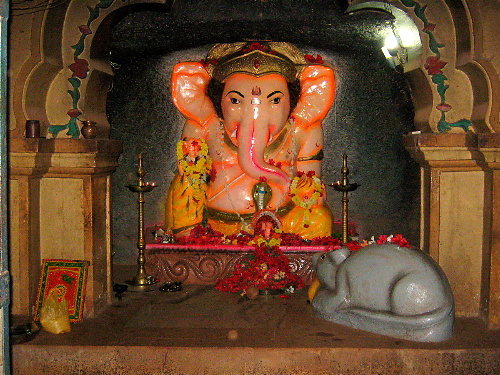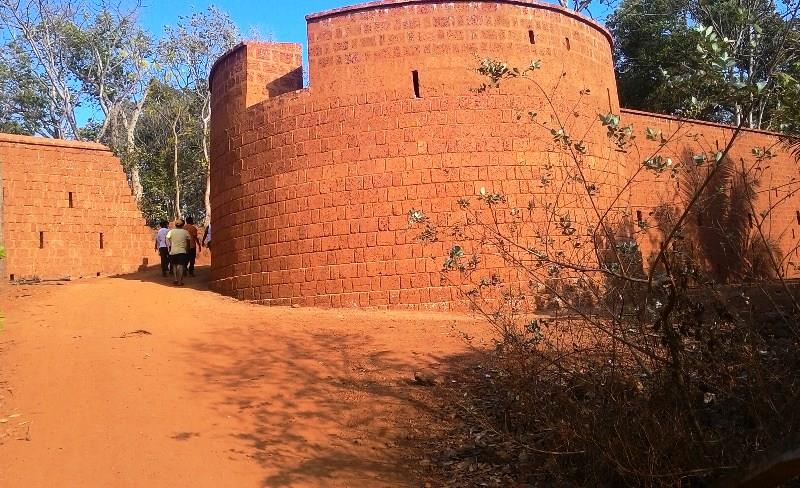
Ganapati Temple, Redi
The Ganapati temple of Redi is located approximately 30 km from Vengurla, in the small village of Redi. The town in which this temple is situated contains iron ore mines and the Ganpati idol was found in one of the mines near Rewati port in 1976. A local person by the name of Sadashiv Kambli supposedly visualized a buried statue of Lord Ganesha in his dream and convinced local workers to dig out the statue from the seashore. After an investigation it has been found that the statue was made by the Pandava during their rule. The statue is approximately 6 ft in height and 4 ft in width. The Ganesh idol is in a sitting position and is Dwibhuja (two arms) as compared to rest of the idols which are generally Chaturbhuja (four arms). The mouse idol (vahana) was found on further excavation after two months.
Yashwantgad Fort
Yashwantgad Fort is located in Redi, Maharashtra, near the Maharashtra-Goa border. It is located on a small hill North of Jaitapur creek. It is a tree-entangled ruin that looks out over the beaches of the south Maharashtra coast.
In the 610-611AD Redi was an important trading port of the Chalukya Swamiraja. Redi Fort was built by the Marathas between 1707 and 1713 part of Admiral Kanhoji Angre’s line of fort defences built for Maratha Queen Tarabai Bhosale.

It was later captured by the Portuguese in 1746. The previous Citadel holders, the Sawant clan of Maharashtra, were desperate to regain the fort because of its valuable strategic position on the coast. An attempt to recapture Redi fort was preceded by poisoning the Portuguese Garrison’s fish supply, but the attack was unsuccessful.] The fort was eventually returned to the Sawants following a peace treaty, but the success was short lived – in 1765 the fort was captured by the British who later sold the land to local people in 1890 while retaining ownership of the fort walls. In 2012, the Fort was the property of Vishwanath R. Patki, whose family had been ‘given the land and the fort as a “gift” by the erstwhile British government in the late 1800s, for services rendered’, according to B.V. Kulkarni, Deputy Director, Directorate of Archaeology & Museums, Maharashtra. In 2016 the Fort was made a Protected Monument, and ‘now it is in our control and we shall prepare a long-term conservation plan which will eventually make it a tourist attraction,’ Kulkarni said.
The area of the fort is 3 hectares. The Fort is built on two levels – the Lower Fort, which is the larger one with its base touching the creek and a fresh water well inside, and the Upper Fort, which is smaller and on a hillock to keep watch on maritime activities in the surrounding waters. There is a dry moat 20feet deep around the fort. There are four gates to be passed to enter the fort. the entrance gates and the guard vestibules are in good condition. The balekilla or Sanctum Sanctorum is a zigsaw puzzle, there are many buildings and wards in good condition. Yashwantgad Fort, Shiroda, Aravali and the Terekhol Fort are a few historic monuments that are worth a visit. Redi is also a nature’s paradise. The Redi Beach is a panoramic stretch lined with lovely coconut and beetle nut trees apart from cashew and mango plantations. Redi Weather The climate in Redi is inviting and warm throughout the year. It experiences a tropical climate which means that the summers are slightly hot, though the cool winter breezes more than make up for it. It serves as a viable retreat for almost the entire year. However, the post monsoon season is your best bet. How To Reach Redi Redi doesn’t possess a railway station or an airport. However, this does not hamper the travel to this scenic spot. The International Airport at Goa and the Sawantwadi Railway Station ensure smooth and memorable journeys. By road, the host of state buses are not only comfortable for a ride but also economical.
ROYAL RETREAT
The Yashwantgad fort has a history dating to the Adilshah of Bijapur, Khem Sawants of Sawantwadi, Chatrapati Shivaji Maharaj, Portuguese and British. Shivaji Maharaj captured it from the Adilshah and named it ‘Yashwantgad.’
